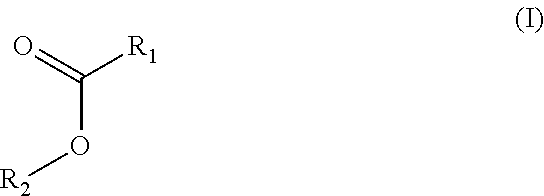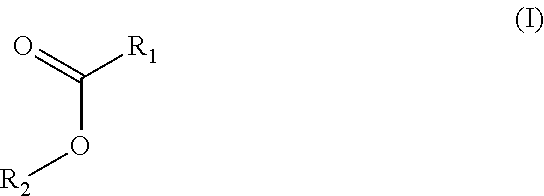Topical Anti-pruritic compositions and methods of action of same
a composition and anti-pruritis technology, applied in the field oftopical anti-pruritis compositions, can solve the problems of patients inadvertently spreading the dermatological disorder to uninfected areas, affecting a large population, and affecting the effect of pruritus, and effective treatment of the diseas
- Summary
- Abstract
- Description
- Claims
- Application Information
AI Technical Summary
Benefits of technology
Problems solved by technology
Method used
Image
Examples
example 1
[0137]The following example illustrates the preparation of a present preferred lotion:
% W / WPramoxine Hydrochloride1.08Benzyl Alcohol1.0Carbomer 9400.7Cetyl Alcohol1.0Dimethicone0.9Glyceryl Stearate (&) PEG-100 Stearate0.51Isopropyl Myristate0.25Petrolatum5.0PEG 8 Stearate1.0Purified Water87.25Stearic Acid1.0Sodium Hydroxide0.308100.0%
[0138]Preparation of the Lotion:
[0139]An aqueous composition is prepared by heating 90% of the water to about 70° C. The Carbomer 940 is then hydrated in the aqueous composition with adequate stirring.
[0140]An oily composition is prepared by heating the cetyl alcohol, dimethicone, glyceryl stearate (&) PEG-100 stearate, isopropyl myristate, petrolatum, PEG 8 stearate, and stearic acid to about 70° C. and stirring until all the ingredients are melted.
[0141]The oily composition is then added to the aqueous composition at a temperature of about 70° C. to obtain an oil-in-water composition.
[0142]The pramoxine hydrochloride is then dissolved in a portion of ...
example 2
[0145]A patient is suffering from pruritus. A preferred composition herein is topically administered to the patient. It would be expected that the patient would improve his / her condition or recover.
example 3
[0146]A patient is suffering from a damaged skin lipid barrier induced by excessive scratching from a pruritic skin condition. A preferred composition herein is topically administered to the patient. It would be expected that the patient would improve his / her condition or recover.
Comparative Study
[0147]A randomized, single-blind, left / right, bilateral pilot study was carried out to compare the efficacy and safety of the present compositions to a 1% hydrocortisone cream. A study group of 30 subjects with mild atopic dermatitis were assigned each of two compositions. The first composition comprised the composition of Example 1, and the second composition comprised a 1% hydrocortisone cream. There was one application of each composition at baseline, with evaluations over 4 hours. All subjects applied study material in the office, with the first composition comprising the composition of Example 1 randomly applied to the right or left side of the body to a pruritic atopic area, and the s...
PUM
| Property | Measurement | Unit |
|---|---|---|
| temperatures | aaaaa | aaaaa |
| temperature | aaaaa | aaaaa |
| temperature | aaaaa | aaaaa |
Abstract
Description
Claims
Application Information
 Login to View More
Login to View More - R&D
- Intellectual Property
- Life Sciences
- Materials
- Tech Scout
- Unparalleled Data Quality
- Higher Quality Content
- 60% Fewer Hallucinations
Browse by: Latest US Patents, China's latest patents, Technical Efficacy Thesaurus, Application Domain, Technology Topic, Popular Technical Reports.
© 2025 PatSnap. All rights reserved.Legal|Privacy policy|Modern Slavery Act Transparency Statement|Sitemap|About US| Contact US: help@patsnap.com


